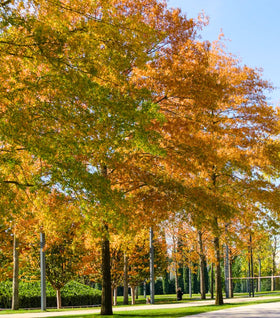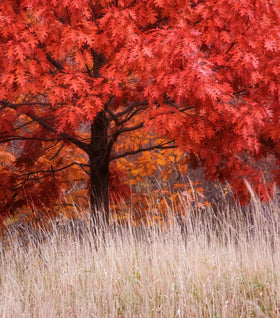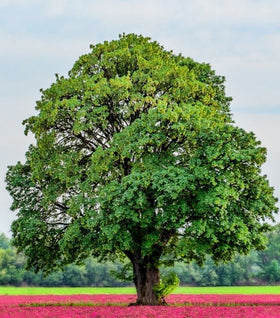Oak Trees for Sale Online
Let us help you add some amazing fall colors to your landscape with easy to grow Oak Trees. Throughout the United States, the wide variety of oak leaves changing color in the fall, is a sight to behold. Making lovely shade trees, there are some fast growing varieties that will give shade relatively quickly. From pin oak to willow oak and white oak trees, you have a lot of options when it comes to live oak trees that be planted in North America. Oak trees are classified as a hardwood species which means that there is little reason to worry about damage to the trees during storms. One of the oldest and most famous oak trees is the "Angel Oak" in Charleston South Carolina. Visitors come from around the country to see the statuesque tree which is estimated to be between 400 to 500 years old but some say it could be up to 1500 years old.
Buy Oak Trees Online
Fall is a time for nuts and no nut is more noticeable than the acorn, the fruit of oak trees, and the food of wildlife. Oak trees are important for a number of reasons. The oak tree belongs to the Quercus genus tree species. There are up to 800 species all over the world, especially in the Northern hemisphere where they are native. It’s a long-lived tree that can live for more than 1000 years. The oak is a tree with multiple uses: the boiled bark is said to have therapeutic properties.
The fruit (acorn) of Oak trees is used to feed livestock and in times of shortage has also been used for human consumption. A meadow of oaks is a refuge for many animal species. The shape of the blade is very characteristic and is found in badges, coins, and medals. Oak trees support a complex ecosystem with many species, including humans. The oak is one of the most loved trees by humans, and it can be easily found in many artistic creations.
Types of Oak Trees
-
Pin Oak Tree
The Pin Oak Tree, Quercus palustris, is one of the faster-growing members of the Oak Family. It looks great as a central focal point in your yard or near your home to provide relief from the summer sun. Growing 50 to 60 feet tall and 30 to 40 feet wide, the Pin Oak is a wonderful shade type of tree. Pin Oak Trees grow at a fast rate, up to 24" a year, in a pyramidal shape. -
Willow Oak Tree
The Willow Oak Tree is a true, American classic. A large tree that is long-lived and grows to amazing heights, the Willow Oak Tree is a great source of shade and food. Willow Oak Trees are often planted alongside roads, in parks, and in the yards of rural and suburban homes. Reaching heights of 50 to 60 feet and a spread of 30 to 40 feet, Willow Oaks is an ideal specimen and shade tree. -
Sawtooth Oak Tree
As one of the fastest-growing trees in its youth, the Sawtooth Oak is an attractive shade tree with dark lustrous summer foliage and clear yellow to golden brown fall leaves. Adaptable to any soil condition except alkaline. One-inch acorns are quite popular with wildlife. Sawtooth Oak trees grow to be 40 to 60 feet tall with 40 to 60 feet spread. -
Northern Red Oak Tree
Also known as Quercus rubra, they have bristle-tipped leaves that turn red in the fall. The leaves have 7 to 11 waxy lobes. They make a good street tree, tolerate pollution, and compact soil. Northern Red Oak can grow as much as two feet a year for 10 years. The northern red oak grows to a height of 60–75' and a spread of around 45' at maturity.
How to plant an Oak Tree?
Dig a hole 3 to 4 times wider than the container. The hole should have sloping sides like a saucer to allow for proper root growth.
Carefully remove the tree from the container keeping the soil around the roots intact. It helps to tap the outside of the container to loosen the edge. Carefully slide the tree from the container. Don't yank the tree out of the container as this can separate the roots from the tree.
Sometimes containerized trees become root-bound or the roots look like they're about to circle the root ball. If your tree is like this, cut an X across the bottom of the root ball and four vertical slices along the sides of the root ball with a sharp knife.
Set the tree in the middle of the hole. Avoid planting the tree too deep. If the root collar sits below the top of the hole, compact some soil under the tree so that the root flare at the base of the trunk is slightly above ground level. Using some soil, secure the tree in a straight position, then fill and firmly pack the hole with the original soil, making sure there aren't any air pockets. Keep backfilling until the soil is just below the root collar.
Create a water-holding basin around the hole and give the tree a good watering. After the water has soaked in, spread protective mulch 2–4 inches deep in a 3-foot diameter area around the base of the tree, but not touching the trunk.
The soil and mulch around your trees should be kept moist but not soggy. During dry weather, generously water the tree every 7 to 10 days during the first year. Water slowly at the dripline.
Keeping your trees watered is important during their first year. Keep the soil and mulch moist but not soggy. In dry weather, you should water generously every 7–10 days. The water should soak into the soil and mulch. Avoid watering so much that you see standing water.
Interesting notes about Acorns
Like many trees, oaks have irregular cycles of boom and bust. Boom times, called “mast years,” occur every 2-5 years, with few acorns in between. But the why and how of these cycles are still one of the great mysteries of science.
Scientific research can tell us what a mast year is not. A mast year is not a predictor of a severe winter. Unfortunately, plants and animals are no better at predicting the future than we are.
Strangely, mast years are not simply resource-driven. Sure, a wet, cool spring can affect pollination and a hot, dry summer can affect acorn maturation. But annual rainfall and temperature fluctuations are much smaller in magnitude than acorn crop sizes. In other words, weather variables cannot account for the excessive, over-the-top, nutty production of acorns in a mast year.
So what does trigger a mast year? Scientists have proposed a range of explanations—from environmental triggers to chemical signaling to pollen availability—but our understanding is hazy and the fact is that we simply don’t know yet.
Boom and bust cycles of acorn production do have an evolutionary benefit for oak trees through “predator satiation.” The idea goes like this: in a mast year, predators (chipmunks, squirrels, turkeys, blue jays, deer, bears, etc.) can’t eat all the acorns, leaving some nuts for growing into future oak trees. Years of lean acorn production keep predator populations low, so there are fewer animals to eat all the seeds in a mast year. Ultimately, a higher proportion of nuts overall escape the jaws of hungry animals.
There are about 90 species of oaks in North America. All oak trees produce acorns. There is no such thing as an Acorn Tree. Acorns belonging to trees in the Red Oak group take two growing seasons to mature and acorns in the White Oak group mature in one season. Oak trees have greenish, inconspicuous female flowers and are wind-pollinated. Oak trees of North America annually produce more nuts than all the region’s other nut trees together, wild and cultivated. One huge oak can drop up to 10,000 acorns in a mast year! Masting takes a lot of energy! Oak trees grow slowly in a mast year and grow well the year after.
When you buy oak trees online from Woodies Garden Goods Direct, you will be adding a wonderful specimen to your garden as well as helping the environment. Many animals depend upon the highly-nutritious acorn for survival.




